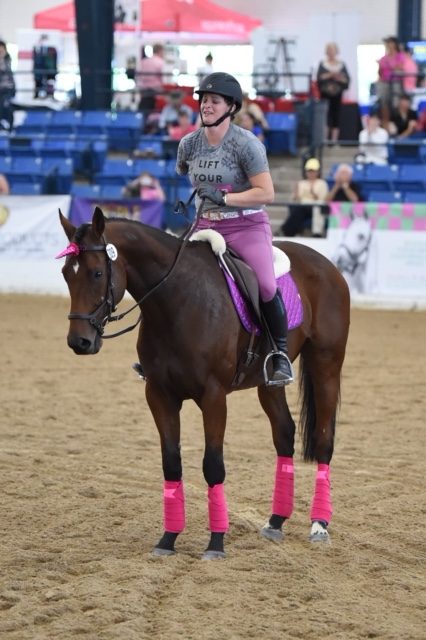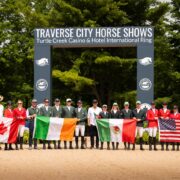What To Expect If You Want To Go To the RRP Thoroughbred Makeover

When Sarah Hepler rode down center line in the Rolex Stadium at the Kentucky Horse Park, chills shot down the length of her arm.
Sarah isn’t a professional competing at the international level. She was aboard her 2018 Retired Racehorse Project mount, Fletcher, a bay Thoroughbred gelding. Two months before, Fletcher was still running at the racetrack in upstate New York. But he was as cool as a cucumber as he competed with Sarah, 39, who showed in both the dressage and dressage freestyle classes.
Tears would spill down her cheeks when she halted for her final salute during her freestyle test. Adorned in purple breeches and a grey T-shirt that said “Lift Your Sister”, the right arm sleeve noticeably empty, her friends inscribed the negative words and insults that served as barriers to them as women and equestrians.
“You’re too fat”, read one note written in black Sharpie on the shirt. “You’ll never be good enough”, read another.
There wouldn’t be a dry eye in the house. Even the judges would write in the test comments that Sarah, the one-armed dressage rider, made them cry.

“The Thoroughbred Makeover is the perfect example of how a horse show should be,” said Sarah, who competed for the first time in 2017 with a mare named Birdie. “Everyone is just so supportive and excited to have you there. Everyone wants to see you succeed. Trainers like (professional international eventer) Elisa Wallace are just so approachable.”
Every year the nonprofit organization, the Retired Racehorse Project, hosts its Thoroughbred Makeover competition. Hundreds of amateurs and professionals from across the country flock to Kentucky for the annual event, to show off their ex-racers turned hunters, jumpers, eventers, barrel racers, etc., for a chance to be named the “America’s Most Wanted Thoroughbred.”
Hundreds more apply every year with hopes of being accepted and making it to the competition. All it takes is a Thoroughbred with 10 months or less of re-training after a racing career.
“There are some people who go in to win and for the money, but the vast majority are there to let their horse have the experience, to bond with other people, and to just enjoy and celebrate the breed,” said Aubrey Graham, a horse trainer near Atlanta.
She brought her first OTTB, Forrest, and a client’s horse to the Thoroughbred Makeover last year to compete in eventing and jumpers. She hopes to bring two more this year.
“My horse had just a little bit of work before the Makeover, so I went in without any big expectations. I just wanted him to experience it and have a good time,” Aubrey said. “But every day that he was there, he just got better.”
She’d end up placing 10th out of 100 in a jumper class.
While the competition aspect is a draw for many, it’s the community and inspiring “can-do attitude” that’s launched the RRP into the spotlight among horse circles.
Riders don’t have to have a long list of show accolades to apply or compete. And the horses aren’t expected to be “made” by any sense of the word.
“If you’re thinking about it, just do it,” Sarah said. She suggested working with a local rescue or post-racing nonprofit to find a suitable mount. But many private farms and trainers sell RRP-eligible horses that are already restarted.
Like This Story? Try: This Legally Blind Eventer Is Still Chasing Her Dreams
For her horses, Sarah focused on trailering off property for clinics, lessons and horse shows in advance of traveling to the big event.
Aubrey’s advice is similar. She worked hard to get her horses exposure at horse shows and other events.
“When I came off the high from the last makeover, I knew I just wanted to do this all the time,” said Aubrey, 35, who is transitioning out of her 40-hour-a-week job in academia at Emory University to train horses full time. She has nine horses currently in her program. It was trainers and new friends she met at the Makeover event who encouraged and helped her through the change.
“These people want the breed and the horses to succeed. They are so free with their knowledge,” she said.
While the event is inspiring and invigorating, Aubrey also warns it’s a lot of work. And it isn’t cheap.
“The vast majority of us aren’t coming from oodles of money. OTTBs tend to be a pretty good deal when you buy them. But they’re still expensive. We’re just a group of people making it work.”
“Everyone is just so supportive and excited to have you there. Everyone wants to see you succeed.”
Sarah lost her arm in a car accident when she was just nine years old. She learned to ride without it. But for years, she shied away from riding para-dressage.
“I didn’t want people to think I needed something separate or special, so I avoided it,” she said. That is, until the Thoroughbred Makeover last year. Her emotional freestyle was the first para-dressage test she ever rode.
Fletcher and Sarah would place third out of about 180 and eighth out 50 in their classes. She’d head home back to the real world, with her job and the farm waiting for her in New York. But she’d leave with a full heart, with her forever heart horse, and with memories to last a lifetime.
And she’ll be back in 2019. She’s already got the horse to hang her next dreams on. His name is Calvin.
Photos by GRC Photo and Kassie Colson


